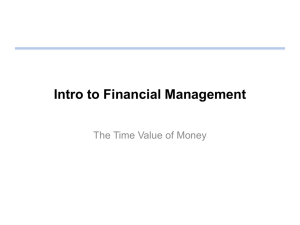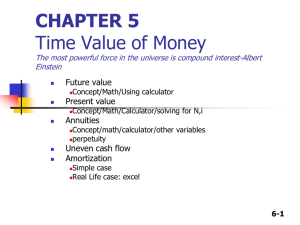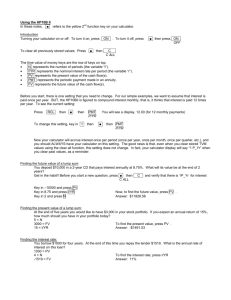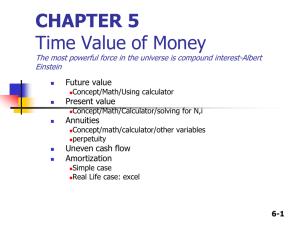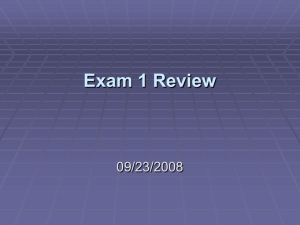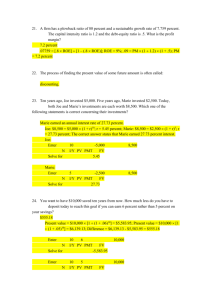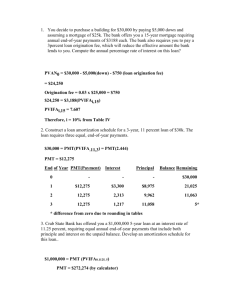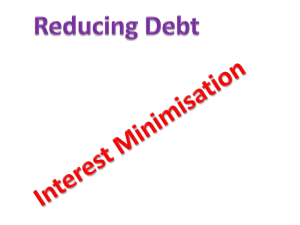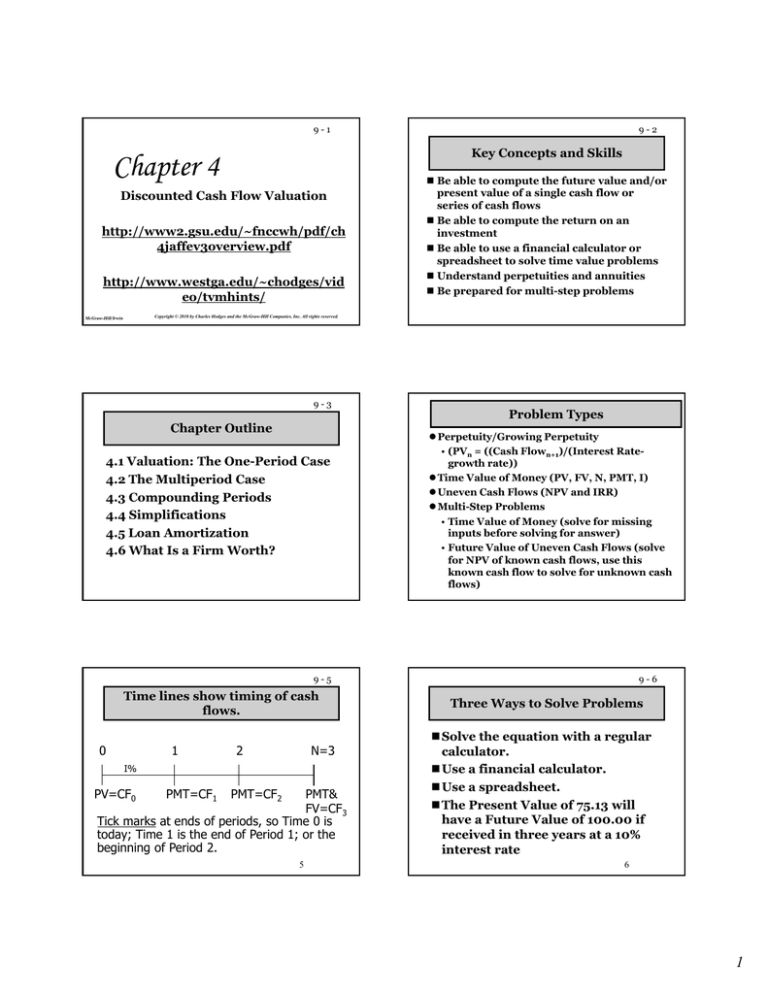
9-1
9-2
Key Concepts and Skills
Chapter 4
Discounted Cash Flow Valuation
http://www2.gsu.edu/~fnccwh/pdf/ch
4jaffev3overview.pdf
http://www.westga.edu/~chodges/vid
eo/tvmhints/
Be able to compute the future value and/or
present value of a single cash flow or
series of cash flows
Be able to compute the return on an
investment
Be able to use a financial calculator or
spreadsheet to solve time value problems
Understand perpetuities and annuities
Be prepared for multi-step problems
Copyright © 2010 by Charles Hodges and the McGraw-Hill Companies, Inc. All rights reserved.
McGraw-Hill/Irwin
9-3
Chapter Outline
4.1 Valuation: The One-Period Case
4.2 The Multiperiod Case
4 3 Compounding Periods
4.3
4.4 Simplifications
4.5 Loan Amortization
4.6 What Is a Firm Worth?
9-4
Problem Types
z Perpetuity/Growing Perpetuity
• (PVn = ((Cash Flown+1)/(Interest Rategrowth rate))
z Time Value of Money (PV, FV, N, PMT, I)
z Uneven Cash Flows ((NPV and IRR))
z Multi-Step Problems
• Time Value of Money (solve for missing
inputs before solving for answer)
• Future Value of Uneven Cash Flows (solve
for NPV of known cash flows, use this
known cash flow to solve for unknown cash
flows)
9-5
Time lines show timing of cash
flows.
0
1
2
N=3
I%
PV=CF0
PMT=CF1
PMT=CF2
PMT&
FV=CF3
Tick marks at ends of periods, so Time 0 is
today; Time 1 is the end of Period 1; or the
beginning of Period 2.
5
9-6
Three Ways to Solve Problems
Solve the equation with a regular
calculator.
Use a financial calculator.
Use a spreadsheet.
The Present Value of 75.13 will
have a Future Value of 100.00 if
received in three years at a 10%
interest rate
6
1
9-7
Solve FVN = PV(1 + I )N for PV
PV =
FVN
(1+I)N
= FVN
1
9-8
Financial Calculator Solution
N
INPUTS
1+I
3
N
10
I/YR
OUTPUT
PV = $100
1
1.10
3
PV
-75.13
0
PMT
100
FV
Either PV or FV must be negative. Here
PV = -75.13. Put in $75.13 today, take
out $100 after 3 years.
http://www.tvmcalcs.com/calculator_index
= $100(0.7513) = $75.13
7
8
9-9
Spreadsheet Solution
9 - 10
Continuous Compounding
= FV(I, N, PMT, PV, type)
= PV(0.10, 3, 0, -100.00) = 75.13
http://spreadsheets.about.com/od
/excel101/Excel_101_How_to_Us
e_Excel_Spreadsheets.htm
The general formula for the future value of an
investment compounded continuously over many
periods can be written as:
FV = C0×erT
Where
C0 is cash flow at date 0,
r is the stated annual interest rate,
T is the number of years, and
e is a transcendental number approximately
equal to 2.718. ex is a key on your calculator.
9
9 - 11
9 - 12
4.4 Simplifications
Perpetuity
Perpetuity
z A constant stream of cash flows that lasts forever
Growing perpetuity
z A stream of cash flows that grows at a constant
rate forever
Annuity
z A stream of constant cash flows that lasts for a
fixed number of periods
Growing annuity
z A stream of cash flows that grows at a constant
rate for a fixed number of periods
A constant stream of cash flows that lasts
forever
C
C
C
…
1
0
2
3
PV =
C
C
C
+
+
+"
2
(1 + r ) (1 + r ) (1 + r ) 3
PV =
C
r
2
9 - 13
9 - 14
Growing Perpetuity
Growing Annuity
A growing stream of cash flows that lasts
forever
C
C×(1+g) C ×(1+g)2
A growing stream of cash flows with a fixed maturity
C
C×(1+g)
C ×(1+g)2
1
2
3
"
…
0
1
PV =
2
0
3
C
C × (1 + g ) C × (1 + g ) 2
+
+
+"
(1 + r )
(1 + r ) 2
(1 + r ) 3
C
PV =
r−g
C×(1+g)T-1
PV =
C
C × (1 + g )
C × (1 + g )T −1
+
+
+
"
(1 + r )
(1 + r ) 2
(1 + r )T
PV =
T
C ⎡ ⎛ 1+ g ⎞ ⎤
⎟⎟ ⎥
⎢1 − ⎜⎜
r − g ⎢ ⎝ (1 + r ) ⎠ ⎥
⎣
⎦
9 - 15
9 - 16
Growing Annuity: Example
4.5 Loan Amortization
A defined-benefit retirement plan offers to pay
$20,000 per year for 40 years and increase the
annual payment by 3% each year. What is the
present value at retirement if the discount rate is
10%?
$20,000
$20,000×(1.03) $20,000×(1.03)39
"
0
1
2
40
$20,000 ⎡ ⎛ 1.03 ⎞ ⎤
⎟ ⎥ = $265,121.57
⎢1 − ⎜
.10 − .03 ⎣⎢ ⎝ 1.10 ⎠ ⎦⎥
40
PV =
T
Pure Discount Loans are the simplest form
of loan. The borrower receives money today
and repays a single lump sum (principal and
interest) at a future time.
time
Interest-Only Loans require an interest
payment each period, with full principal due
at maturity.
Amortized Loans require repayment of
principal over time, in addition to required
interest.
9 - 17
9 - 18
Amortized Loan with Fixed Payment
Each payment covers the interest expense plus
reduces principal
Key relationships
zBeginning Balance = Previous Ending Balance
y
= Principal
p + Interest
zPayment
zInterest = Beginning Balance * Interest Rate
zBeginning Balance – Principal = Ending Balance
Consider a 4 year loan with annual payments. The
interest rate is 8% ,and the principal amount is
$5,000. What is the annual payment?
• 4 N, 8 I/Y, 5,000 PV, CPT PMT = -1,509.60
Amortized Loan
Year
Beginning Total
Interest
Balance Payment Paid
Principal Ending
Paid
Balance
0
5000.00
1 5,000.00 1,509.60
Totals
400.00 1,109.60 3,890.40
2 3,890.40 1,509.60
311.23 1,198.37 2,692.03
3 2,692.03 1,509.60
215.36 1,294.24 1,397.79
4 1,397.79 1,509.60
111.82 1,397.78
0.01
6,038.40 1,038.41 4,999.99
3
9 - 19
4.6 What Is a Firm Worth?
Conceptually, a firm should be
worth the present value of the
firm’s cash flows.
The tricky part is determining the
size, timing, and risk of those cash
flows.
9 - 20
Contact Information
Office: RCOB 18, U. of West Georgia
Office Phone and Voicemail: (770)301-
8648 (cell) or (678)839-4816 (office)
Class
Cl
W
Webpage:
b
Ul
Ulearn
E-mail: Ulearn (preferred) or
chodges@westga.edu or
chodges@gsu.edu
Social Networking: Facebook, LinkedIn,
and Instant Messenger
mba8622@hotmail.com
4

